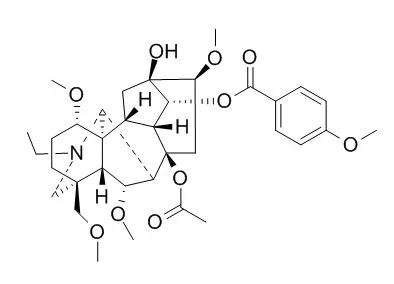| Description: |
Crassicauline A, a diterpenoid alkaloid in Aconitum herbs, is an analgesic drug clinically used in China. Crassicauline A possesses feeding deterrent activity against T. castaneum adults, with the EC(50) value of 1134.5 ppm. |
| In vitro: |
| Talanta. 2012 Aug 15;97:491-8. | | Measurement of yunaconitine and crassicauline A in small-volume blood serum samples by LC-MS/MS: tracing of aconite poisoning in clinical diagnosis.[Pubmed: 22841113] | Aconite poisoning is one of the most serious types of herb-related medical emergencies. In Hong Kong, many if not most of these poisoning cases are due to confusion in herbal species; that is, the wrong herbs are used in prescriptions. Such human errors, while inevitable perhaps, can be serious, and sometimes fatal. The chemical components responsible for aconite poisoning are yunaconitine and Crassicauline A.
METHODS AND RESULTS:
In the present study, a rapid and sensitive method for the screening and quantification of yunaconitine and Crassicauline A in human serum, using LC-MS/MS, was developed and validated. Methyllycaconitine was chosen as the internal standard. The limit of detection (LOD) of yunaconitine and Crassicauline A were found to be 0.022 and 0.021 ng/mL, respectively. The limit of quantification (LOQ) was 0.1 ng/mL for both yunaconitine and Crassicauline A. The recovery of yunaconitine and Crassicauline A ranged from 78.6% to 84.9% and 78.3% to 87.2%, respectively. The matrix effect of yunaconitine and Crassicauline A ranged from 110.0% to 130.4% and 121.2 to 130.0%, respectively. Both yunaconitine and Crassicauline A were stable in serum for at least 3 months at -20 °C, and the extracts were stable for at least 7 days. For clinical applications, serum samples of two patients confirmed to have had aconite herbs poisoning in 2008 were quantified using the developed method.
CONCLUSIONS:
The result showed that this method can be utilized in clinical routine applications. This screening method expedites the diagnosis in cases of suspected aconite poisoning, thus enabling doctors to treat the condition more quickly and effectively. |
|
| In vivo: |
| J Agric Food Chem. 2011 Apr 27;59(8):3701-6. | | Feeding deterrents from Aconitum episcopale roots against the red flour beetle, Tribolium castaneum.[Pubmed: 21417277] | The screening for insecticidal principles from several Chinese medicinal herbs showed that the ethanol extract of Aconitum episcopale roots possessed significant feeding deterrence against the red flour beetle, Tribolium castaneum .
METHODS AND RESULTS:
From the ethanol extract, six feeding deterrents were isolated by bioassay-guided fractionation. The compounds were identified as chasmanine, Crassicauline A, karacoline, sachaconitine, talatisamine, and yunaconitine from their spectroscopic data. Chasmanine, talatisamine, karacoline, and sachaconitine exhibited feeding deterrent activity against T. castaneum adults, with EC(50) values of 297.0, 342.8, 395.3, and 427.8 ppm, respectively.
CONCLUSIONS:
Yunaconitine and Crassicauline A also possessed feeding deterrent activity against T. castaneum adults, with EC(50) values of 653.4 and 1134.5 ppm, respectively. |
|






 Cell. 2018 Jan 11;172(1-2):249-261.e12. doi: 10.1016/j.cell.2017.12.019.IF=36.216(2019)
Cell. 2018 Jan 11;172(1-2):249-261.e12. doi: 10.1016/j.cell.2017.12.019.IF=36.216(2019) Cell Metab. 2020 Mar 3;31(3):534-548.e5. doi: 10.1016/j.cmet.2020.01.002.IF=22.415(2019)
Cell Metab. 2020 Mar 3;31(3):534-548.e5. doi: 10.1016/j.cmet.2020.01.002.IF=22.415(2019) Mol Cell. 2017 Nov 16;68(4):673-685.e6. doi: 10.1016/j.molcel.2017.10.022.IF=14.548(2019)
Mol Cell. 2017 Nov 16;68(4):673-685.e6. doi: 10.1016/j.molcel.2017.10.022.IF=14.548(2019)